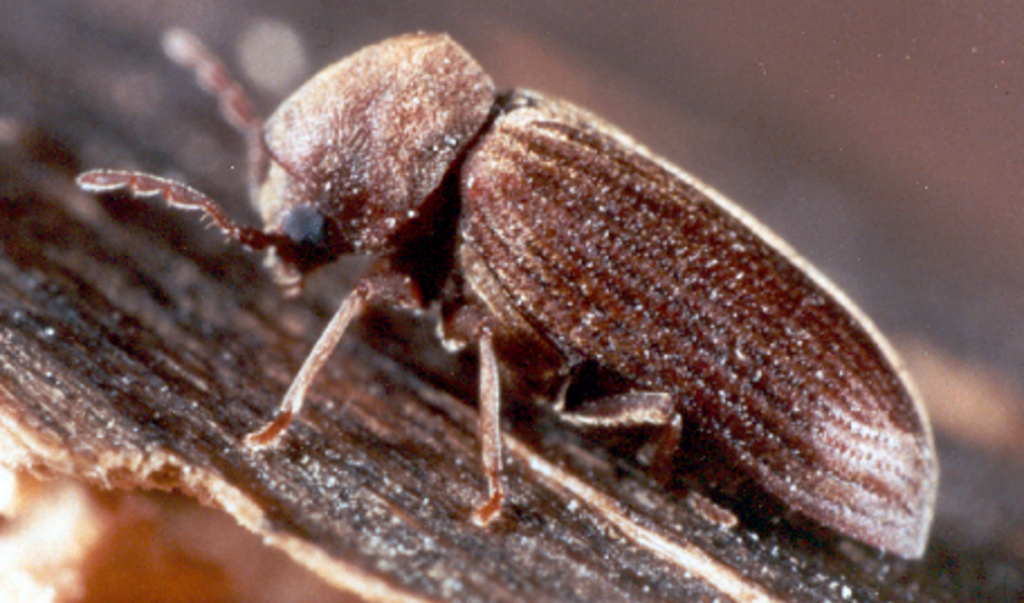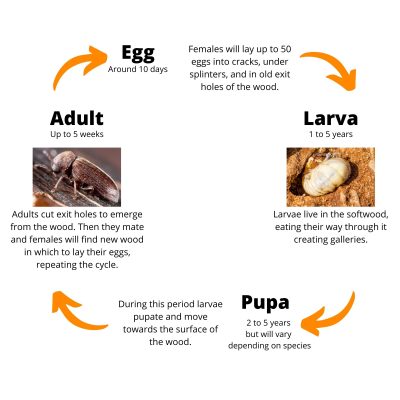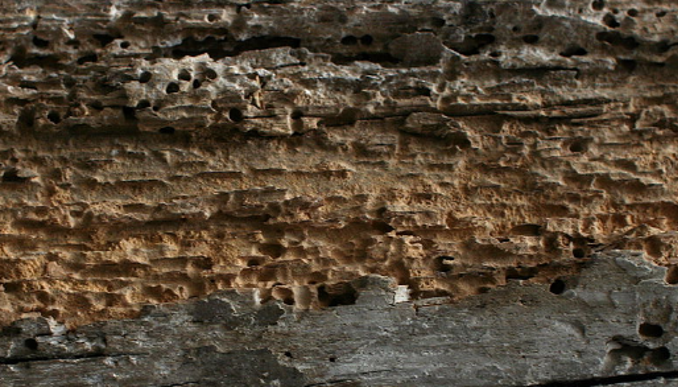
How to identify wood-boring beetles
Wood-boring beetles are various species and families of insects whose larval or adult forms feed off and destroy wood products.
There are four primary families or subfamilies used to classify woord-boring beetles, each with distinct characteristics that can help identify them. The acronym ALBO can help recall the four groups: Anobiid, Lyctid, Bostrichid, and Old house borer or Cerambycid. Knowing what signs to look for and how to identify each type of family will help determine treatment and control measures. Although each family has a particular preference for a type of wood (hardwood, softwood, or both) in most cases, the beetle larvae do the most damage.
How are they brought inside?
Infestation can originate in several ways so it is necessary to be mindful of the wood and furniture that enters the home. One of the easiest ways for these wood-boring beetles to enter any home is via wood brought inside. This is usually in firewood or second-hand furniture that has been previously infested and still contains eggs or larvae. Woodworms have a 2 to 5-year life cycle, meaning they remain under the wood’s surface for as long before emerging. When buying second-hand furniture, it is best to be careful as this can lead to an infestation.
It is also important to note that adult wood-boring beetles can fly short distances. While an infestation may not originate inside the home, this may begin in the hard or softwood surrounding it. While foraging for food, adults may fly through open windows or cracks in the foundation or walls. If the timing is right and the females find an ideal location, they will lay eggs in cracks and crevices of exposed wood. These eggs become larvae that burrow into the wood to feed and develop before eventually leaving via freshly chewed exit holes.
Life cycle
In general, wood-boring beetle larvae (woodworms) cause the most damage. Adult females lay eggs in the wood where they are left to hatch and develop. Development may take anywhere from 5 to 10 years depending on the beetle type. During this development stage, larvae tunnel into the wood, feeding continually to grow. When the larvae become adults, they cut exit holes to emerge from the wood, mate, and the females will lay eggs again, thus repeating the cycle. The size and shape of the exit holes vary from one beetle to the next. However, the apparition of these exit holes is one of the first steps to recognizing the presence of wood-boring beetles.

Life cycle of an Anobiid beetle
Warning signs and potential dangers
With their under-the-radar activity, wood-boring beetles are typically not detected immediately. Other than the exit holes, there are a couple of signs that may indicate a wood-boring beetle infestation. One of these signs is the presence of frass, a mixture of wood fragments and excrement. Frass often looks like fine, powdery dust, typically found below the infected part of the wood or near exit holes. But depending on the type of beetle and the wood, the frass may take on a slightly different texture. Stained or blistered wood may also indicate the presence of these pets. This may happen due to the larvae tunneling activity just below the wood surface. And a less “visible” but helpful indicator is the sound of woodworms eating through the wood. When this happens, it is possible to hear a rasping or ticking sound from within the wood.
As for wood-boring beetles and woodworms posing a threat to humans, there is no real need to worry. Most studies show that these pests will not directly harm humans. There are, however, parasites linked to specific beetle types that may bite. Instead, homeowners should be concerned about the structural damage accumulating over time. Early detection and treatment, can help limit the spread of infection. If left unnoticed and untreated, the higher the risk may become for severe structural damage. Regardless of the signs and in case of uncertainty, it is best to contact a pest management specialist to assess the property.
Preventing wood-boring beetles
Several steps can help to reduce the threat of a wood-boring beetle infestation. Carefully inspect lumber or timber before use in any construction projects for signs of damage from wood-boring beetles. Regardless of the project, all wood should be pre-treated as a preventative measure against wood-boring beetles and other wood-destroying organisms. Pre-treating or using pre-treated wood reduces the immediate chances of infestation in the case of pests nearby. Wood can also be re-treated with an insecticide to destroy all potential larvae and adult wood-boring beetles. This treatment can prevent their emergence and, in the case of localized infestations, reinfestation.
Additionally, some wood-boring beetles will lay their eggs in the wood used for firewood. Without realizing it, the eggs and larvae enter the house where they can emerge as adults and potentially attack inside the home. To avoid this, firewood should be kept outside and away from the house until used. And as previously mentioned, this also means paying attention to any second-hand furniture brought into the home. It is impossible to know where and under what conditions second-hand furniture was stored before purchase. Whether it is firewood, furniture, or something else, it is encouraged to inspect it before bringing it into the home.

Wood damage from deathwatch beetles
Protection from future infestations
Sealing wood with paint or varnish can help prevent the females from laying their eggs on the surface or inside. Applying a seal to the wood is a way to stop the problem before it even starts. Females won’t be able to lay their eggs which hatch into wood-eating larvae and destroy the wood. Additionally, sealing the wood makes it more resistant to scratches and water damage, which can help deter the females. However, sealing wood isn’t a permanent solution as cracks and scratches may occur over time thus re-exposing the wood to insects. This is why regularly checking treated wood in and outside the home is recommended.
Other than carefully selecting and treating the wood, it is imperative to pay attention to moisture levels. Although it varies based on beetle type, wood needs to contain a specific moisture level for them to feed. Reducing moisture levels in the wood should minimize the chance of wood-boring beetles as they will become less attracted to the wood. If possible, use fans, windows, or central air systems to help ventilate rooms in the home. For spaces where this isn’t possible or that are more humid, a portable fan or dehumidifier can help regulate this.
If you are unsure of the presence of wood-boring beetles, contact your local pest management professional to perform a home inspection. They will be able to advise you and treat the issue if necessary.
If you are a pest control company and are interested in trying MABI injectors for your treatment services, find a distributor here